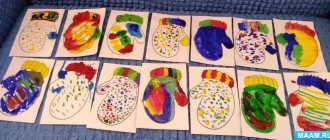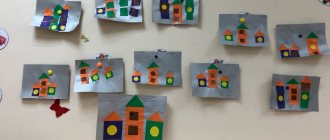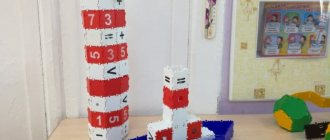Technological map - construct
| Reflection 2-3 min. | Summing up, positive assessment of the result obtained | Expresses sincere admiration. Thanks the children, receives positive feedback from the forest inhabitants. Provides opportunities for independent play. | Children are happy with the results obtained and the positive assessment of their work. They are glad that they were able to help. Participate in play activities. | The children are satisfied with the results of their activities. Express positive emotions. |
Synopsis of the educational activity “In a forest clearing”.
Educational areas:
“Cognitive development”, “Social and communicative development”, “Speech development”, “Artistic and aesthetic development”, “Physical development”.
Kind of activity:
gaming, communicative, motor.
Age group:
younger age.
Temporary resource:
15 minutes.
GCD topic:
"In a forest clearing."
Target:
formation of elementary mathematical concepts; to train children in using mathematical knowledge in a play situation; consolidate children's mathematical concepts through didactic games.
Tasks:
Educational:
— consolidate children’s knowledge about elementary sensory standards (shape, color, size);
- consolidate mathematical concepts: one-many, the same amount (equally), more-less, high-low, big-small;
- to consolidate children’s knowledge about wild animals and the rules of behavior in the forest;
-improve the ability to distinguish and name geometric shapes (circle, square, triangle, rectangle).
Educational:
—
develop attention, memory, communication skills;
-develop the ability to make proposals and draw simple conclusions, to express one’s thoughts clearly for others.
Educational:
- cultivate a sense of compassion and desire to help;
-develop communication skills with adults and peers;
- cultivate love and interest in living nature.
Facilities:
- visual:
bell;
-musical:
musical recordings of forest noise, birdsong;
-materials, equipment:
easel (magnetic board), CD player, set of large geometric shapes, images of hedgehogs and Christmas trees (3 pieces, different in size), a set of numbers from 1 to 5, educational games “Butterflies and Flowers”, “Hide the Mouse”.
Planned result:
they can recognize and name elementary sensory standards (color, shape, size), they can compare using the application method, they can arrange objects by height and size (up to 3 objects) and name them accordingly, they can count to 5 or more.
Attitude to activity:
interest, emotionality, children willingly engage in playful interactions with adults and peers.
Preliminary work:
acquaintance with sensory standards (color, shape, size), viewing pictures of the forest at different times of the year, conversations about the rules of behavior in the forest, about forest inhabitants, didactic games “Moms and their children”, “What color”, “Pick a pair”, “What is round (square, triangular”, “Correspondences”, designing, drawing and applique “House”, listening to musical pieces on the theme “Forest”.
Differences between a technological map and a synopsis
The new Federal State Educational Standards impose special requirements on the modern lesson aimed at increasing its effectiveness.
The lesson should be problematic and developmental in nature, contribute to the formation of personal and subject competencies, learning skills. Also, in the process of introducing the Federal State Educational Standard, the teacher needs to focus on the achievement by schoolchildren of three groups of planned educational results, which should be formulated not in the form of a list of traditional knowledge, skills and abilities, but in the form of formed methods of activity. These requirements should be reflected in the description of the lesson.
The technological map of a lesson according to the Federal State Educational Standard is in the form of a table. However, this is not the only difference from the traditional outline. There are many more of them and they relate to the information content of each of these forms.
Let us give their comparative characteristics (see below).
Thus, recording the progress of a lesson in the form of a technological map gives the teacher the opportunity, even at the stage of preparation for it, to maximally detail its content and effectively reflect the main points of the work program that correspond to the topic of the lesson. Allows you to evaluate the rationality and potential effectiveness of the selected content, forms, methods, means and types of educational activities at each stage of the lesson.
| Technological map of the lesson according to the Federal State Educational Standard | Lesson summary |
| Allows you to demonstrate a system-activity approach during the lesson, since it contains a description of the activities of all participants in the educational process when performing each action, and indicates the nature of the interaction between the teacher and students. | It has the form of a script, which mainly includes a description of the words and actions of the teacher. |
| Includes a description of the students’ activities with an indication of the UUDs formed in the process of each educational action. | Contains an indication and description of the basic forms and methods used in the lesson. |
| Helps to understand the planned results of each type of activity and control this process. | Only the general goals of the entire lesson are indicated. |



